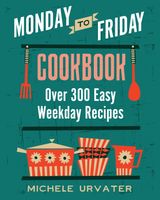Label
All
0
Clear all filters
The Efficient Cook
Appears in
Published 1991

Finally, here are some tips that will save you time and help you get the most out of your culinary efforts.
- The smaller the cut or dice of an ingredient, the faster it cooks.
- To save time, you don’t frozen vegetables, like corn, peas, lima beans, and artichoke hearts, before adding them to soupy dinners like one-pot meals.
- Use high heat to make the process of sautéing or stir-frying a lot faster and efficient. Using high heat is an efficiency trick I learned working in restaurants where everything and every dish is hurried. I make sure the skillet and oil are very hot before I begin to sauté. When I am using a thick and heavy skillet like a cast-iron pan, I heat the pan dry over high heat for a few seconds to speed up the process even more. Then I add the oil, heat it for a few seconds until it is very hot, and begin the cooking procedure. Ingredients “take” to the pan and cook very quickly, saving time.
- When you are in a super hurry, buy precut vegetables—usually carrots, celery, and peppers come this way. But precut vegetables are expensive and not that fresh, so save this tip for out-of-the-ordinary circumstances.
- If you know on Tuesday night (you have your calendar tacked onto your refrigerator) that Wednesday night you won’t have much time to prepare a meal, then wash, chop, dice, and mince extra of whatever ingredients you’re getting ready for Tuesday’s meal and refrigerate the extras in plastic bags. This works for meats and poultry and all vegetables, except for onions, which tend to taste acrid and bitter when cut and left standing. Store extra minced garlic in olive oil so that it doesn’t dry out.
- Don’t buy precut meat, poultry, or vegetables more than a day in advance because all food loses nutritional value once it’s cut and spoils faster than when left whole.
- Whenever you can (even with recipes not from this book), try to use whole packages of frozen vegetables and whole cans of tomatoes, so that you don’t have odd bits and pieces of ingredients that eventually go to waste. For example, if a recipe (from another cookbook) calls for 1 cup frozen corn kernels, use the whole pack instead and either omit something else from the recipe or content yourself with more volume in the dish.
- Cook in oil instead of butter or other animal fats, not only because it is healthier but also because oil doesn’t congeal when at room temperature or chilled. Leftovers that were cooked in oil don’t have to be reheated unless you want them to be; they can be eaten at room temperature or added to a salad.
- Omit steps in recipes (in other cookbooks) that have you doing extra work just to make a dish look good. You’ll notice that although I use lots of fresh herbs, they’re always integral to the flavor of the recipe. I would never go to the trouble of mincing something just to garnish a dish (except when company is coming).
- If how a dish looks is also important to you, then choose vividly colored vegetables with which to season your recipes and accompany main courses.
- Although my recipes are riddled with fresh tomatoes, nary a one has been peeled before chopping. Whenever I think the texture of tomato peel would be unpleasant in a recipe, I use canned peeled tomatoes instead of fresh.
Part of
Advertisement
Advertisement
The licensor does not allow printing of this title


